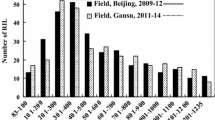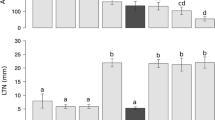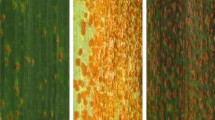Abstract
Slow rusting is considered a crucial component of durable resistance to wheat leaf rust caused by Puccinia triticina and is often expressed in the form of a prolonged latent period. Selection for a longer latent period is considered an effective approach to developing wheat cultivars with improved durable resistance to leaf rust. A recombinant inbred line (RIL) population derived from CI 13227 (long latent period) × Suwon 92 (short latent period) was phenotyped for latent period in two greenhouse experiments in separate years, and amplified fragment length polymorphism (AFLP) and simple sequence repeat (SSR) markers were analyzed in the same population. Among the RILs, the frequency distribution for latent period was continuous, and latent period was highly correlated between years (r=0.94, P<0.0001). A quantitative trait locus (QTL) prolonging the latent period of P. triticina, designated as QLrlp.osu-2DS, explained 42.8% and 54.5% of the phenotypic and genetic variance in the two experiments, respectively. QLrlp.osu-2DS was mapped on the distal region of chromosome 2DS. Two other QTLs for latent period, QLrlp.osu-2B and QLrlp.osu-7BL, were localized on chromosome 2B and the long arm of chromosome 7B, respectively. Multiple regression analysis showed that these three QTLs collectively explained 58.0% and 73.8% of the phenotypic and genetic variance over two experiments, respectively. Fourteen RILs that carried all three alleles for long latent period at three AFLP loci flanking QLrlp.osu-2DS, QLrlp.osu-2B, and QLrlp.osu-7BL had a mean latent period of 12.5 days, whereas 13 RILs without any long-latent-period alleles at the corresponding loci had a mean latent period of 7.4 days. Three SSR markers closely linked to these QTLs have potential to be applied in marker-assisted selection for prolonged latent period in wheat.


Similar content being viewed by others
References
Bai GH, Kolb F, Shaner G, Domier L (1999) AFLP markers linked to one major QTL controlling scab resistance in wheat. Phytopathology 89:343–348
Bjarko ME, Line RF (1988a) Quantitative determination of the gene action of leaf rust resistance in four cultivars of wheat, Triticum aestivum. Phytopathology 78:451–456
Bjarko ME, Line RF (1988b) Heritability and number of genes controlling leaf rust resistance in four cultivars of wheat. Phytopathology 78:456–461
Broers LHM, Jacobs T (1989) The inheritance of host plant effect on latency period of leaf rust in spring wheat. II. Number of segregation factors and evidence for transgressive segregation in F3 and F5 generation. In: Broers LHM, Jacobs T (eds) Histological, genetical and epidemiological studies on partial resistance in wheat to leaf rust. Ponson and Looijen, Wageningen, pp 95–105
Caldwell RM, Roberts JJ, Eyal Z (1970) General resistance (“slow rusting”) to Puccinia recondita f. sp. tritici in winter and spring wheat (abstr.). Phytopathology 60:1287
Clifford BC (1972) The histology of race non-specific resistance to Punccinia hordei in barley. In: Proc Eur Mediterr Cereal Rusts Conf, vol 1. Research Institute of Crop Production, University Press, Prague, pp 75–79
Das MK, Rajaram S, Mundt CC, Kronstad (1992) Inheritance of slow-rusting resistance to leaf rust in wheat. Crop Sci 32:1452–1456
Das MK, Rajaram S, Mundt CC, Kronstad WE, Singh RP (1993) Associations and genetics of three components of slow rusting in leaf rust in wheat. Euphytica 68:99–109
Faris JD, Li WL, Liu DJ, Chen PD, Gill BS (1999) Candidate gene analysis of quantitative disease resistance genes. Theor Appl Genet 98:219–225
Heath MC (1977) A comparative study of non-host interactions with rust fungi. Physiol Plant Pathol 10:73–88
Jacobs T, Broers LHM (1989) The inheritance of host plant effect on latency period of wheat leaf rust in spring wheat. I. Estimation of gene action and number of effective factors in F1, F2 and backcross generations. In: Broers LHM, Jacobs T (eds) Histological, genetical and epidemiological studies on partial resistance in wheat to leaf rust. Ponson and Looijen, Wageningen, pp 79–91
Knott DR (1989) The wheat rusts: breeding for resistance. Springer, Berlin Heidelberg New York, pp 144–145
Kosambi DD (1944) The estimation of map distances from recombination values. Ann Eugen 12:172–175
Kuhn RC, Ohm HW, Shaner G (1978) Slow leaf rusting resistance in wheat against twenty-two isolates of Puccinia recondita. Phytopathology 68:651–656
Lander ES, Green P, Abrahamson J, Barlow A, Daly MJ, Lincoln SE, Newburg I (1987) mapmaker: an interactive computer package for constructing primary genetic linkage maps of experimental and natural populations. Genomics 1:174–181
Lee TS, Shaner GE (1985a) Oligogenic inheritance of length of latent period in six slow leaf-rusting wheat cultivars. Phytopathology 75:643–647
Lee TS, Shaner G (1985b) Transgressive segregation of length of latent period in crosses between slow leaf-rusting wheat cultivars. Phytopathology 75:643–647
Messmer MM, Seyfarth S, Keller M, Schachermayr G, Winzeler M, Zanetti S, Feuillet C, Keller B (2000) Genetic analysis of durable leaf rust resistance in winter wheat. Theor Appl Genet 100:419–431
Michelmore RW, Paran I, Kesseli RV (1991) Identification of markers lined to disease-resistance genes by bulked segregant analysis: a rapid method to detect markers in specific genomic regions by using segregating populations. Proc Natl Acad Sci USA 88:9828–9832
Milus EA, Line RE (1980) Characterization of resistance to leaf rust in Pacific Northwest wheats. Phytopathology 76:93–96
Neervoort WJ, Parlevliet JE (1978) Partial resistance of barley to leaf rust, Puccinia hordei. V. Analysis of the components of partial resistance in eight barley cultivars. Euphytica 27:33–39
Nelson JC (1997b) qgene: software for maker-based genomic analysis and breeding. Mol Breed 3:239–245
Nelson JC, Singh RP, Autrique E, Sorrells ME (1997a) Mapping genes conferring and suppressing leaf rust resistance in wheat. Crop Sci 37:1928–1935
Ohm HW, Shaner GE (1976) Three components of slow leaf-rusting at different growth stages in wheat. Phytopathology 66:1356–1360
Parlevliet JE (1979) Components of resistance that reduce the rate of epidemic development. Ann Rev Phytopathol 17:203–222
Parlevliet JE, Van Ommeren A (1975) Partial resistance of barley to leaf rust, Puccinia hordei. II. Relationship between field trials, micro-plot tests and latent period. Euphytica 24:293–303
Rubiales D, Niks RE (1995) Characterization of Lr34, a major gene conferring nonhypersensitive resistance to wheat leaf rust. Plant Dis 79:1208–1212
Saghai-Maroof MA, Soliman KM, Jorgensen RA, Allard RW (1984) Ribosomal DNA spacer-length polymorphism in barley: Mendelian inheritance, chromosome location, and population dynamics. Proc Natl Acad Sci USA 81:8014–8018
Schnursch T, Pailard S, Schori A, Messmer M, Schachermayr G, Winzeler M, Keller B (2004) Dissection of quantitative and durable leaf rust resistance in Swiss winter wheat reveals a major resistance QTL in the Lr34 chromosomal region. Theor Appl Genet 108:477–484
Shan X, Blake TK, Talbert LE (1999) Conversion of AFLP markers to sequence-specific PCR markers in barley and wheat. Theor Appl Genet 98:1072–1078
Shaner G, Finney RE (1980) New sources of slow leaf-rusting resistance in wheat. Phytopathology 70:1183–1186
Shaner G, Buechley G, Nyquist WE (1997) Inheritance of latent period of Punccinia recondita in wheat. Crop Sci 37:748–756
Somers DJ, Isaac P, Edwards K (2004) A high-density microsatellite consensus map for bread wheat (Triticum aestivum). Theor Appl Genet (10.1007/s00122-004-1740-710.1007/s00122-004-1740-7)
Suenaga K, Singh RP, Huerta-Espino J, William HM (2003) Microsatellite markers for genes Lr34/Yr18 and other quantitative trait loci for leaf rust and stripe rust resistance in bread wheat. Phytopathology 93:881–890
VanderGaag DJ, Jacobs T (1997) Inheritance of host plant effect on latent period of leaf rust in single-seed descent F8 lines. Euphytica 93:67–72
Vos P, Hogers R, Bleeker M, Reijans M, van de Lee T, Hornes M, Frifiters A, Pot J, Peleman J, Kuiper M, Xabeaum M (1995) AFLP: a new technique for DNA fingerprinting. Nucleic Acids Res 23:4407–4414
William HM, Hoisington D, Singh RP, Gonzalez-Leon D (1997) Detection of quantitative trait loci associated with leaf rust resistance in bread wheat. Genome 40:253–260
William M, Singh RP, Huerta-Espino J, Ortiz Islas S, Hoisington D (2003) Molecular marker mapping of leaf rust resistance gene Lr46 and its association with stripe resistance gene Yr29 in wheat. Phytopathology 93:153–159
Zadoks JC (1971) Systems analysis and the dynamics of epidemics. Phytopathology 61:600–610
Acknowledgements
We thank Perry Cregan and Qijian Song (Soybean Genomics and Improvement Laboratory, USDA, ARS, Beltsville Agricultural Research Center, Beltsville, Md., USA) for providing the BARC SSR primer sequences, Richard Ward (Department of Crop and Soil Science, Michigan State University, East Lansing, Mich., USA) and Bikram S. Gill (Department of Pathology, Kansas State University, Manhattan, Kan., USA) for providing mapping information for the BARC SSR markers, and Daryl Somers for providing primer and mapping information for the WMC SSR markers.
Author information
Authors and Affiliations
Corresponding author
Additional information
Communicated by G. Wenzel
Rights and permissions
About this article
Cite this article
Xu, XY., Bai, GH., Carver, B.F. et al. Mapping of QTLs prolonging the latent period of Puccinia triticina infection in wheat. Theor Appl Genet 110, 244–251 (2005). https://doi.org/10.1007/s00122-004-1819-1
Received:
Accepted:
Published:
Issue Date:
DOI: https://doi.org/10.1007/s00122-004-1819-1




